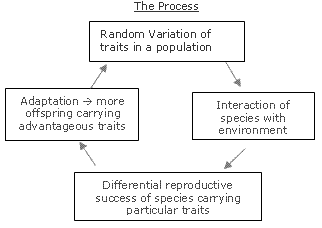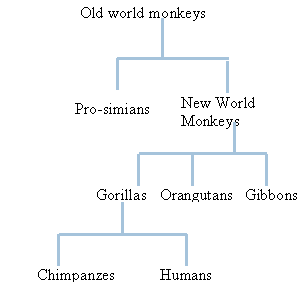 Home » Evolution Quick Review
Home » Evolution Quick ReviewKey Biology Terms
Evolution: Descent with modification
Ancestor: Early type of species from which others have evolved.
Descent: Current day organisms arose from ancestoral forms over time and as a result of mutations
Modification: Refers to changes in a species over time
Natural Selection: The major mechanism of modification during evolution.
Inheritance: Refers to any trait or the assemblage of traits that can be passed down from one generation to the next.
Fossils: Ancient impressions or remnants left in sedimentary rock by extinct species.
Extinct: No members of the species exists today.
Phylogenetic tree: Depiction of the pattern of evolution
Embryology: The study of development of an organism from conception to birth.
Taxonomy: A hierarchical grouping of organisms with ascending categories having more general characteristics.
DNA: Deoxyribonucleic Acid. An organic chemical in four types, that when arranged in particular ways can carry and transfer genetic information from parent to offspring.
Hypothesis: Attempt to explain why observations occur
Gradualism: Idea that evolution occurs via a slow consistent change in traits over time.
Heritable Adaptation: Any inherited trait that ultimately leads to a reproductive advantage of a species.
Punctuated Equilibrium: Evolutionary changes occur relatively quickly followed by long periods of stabilization.
Speciation Event: When members of a new reproductive community no longer interbreed with their ancestoral population as a result of isolation and subsequent accumulation of adaptations to their new environment.
The Process of Natural Selection
-“Selection” is not intended to imply that there is some higher power or force judging and selecting the best species according to some ideal.
-Natural Selection is a result of a species interaction with the environment, with “selection” being determined by whichever species lives long enough to propagate and thereby be successful.
-Survival of the “Fittest”. Fit refers to best fit to environment.
-Survival depends on an organisms fit to the environment.
- Natural Selection cannot predict the future. For example, which variations will appear spontaneously in nature and then prove to benefit a species from a reproductive standpoint

Branches of Phylogenetic Tree
A branch contains the oldest ancestor in that line plus all of its descendants. Relationship between ancestor and descendant determined by number of shared characteristics in common. Each node =speciation event.

Other Key Concepts
Evolution à new traits that help an organism adapt to their environment. Also, over time à speciation event à origin of new species.
Traits acquired through an individual’s experience or behavior can not be coded for in DNA and can not be passed down to offspring.
Environmental changes à more rounds of natural selectionà new trait set à adaptation à over time, new species.
Minor mechanisms of modification:
Gene Flow - individual species breed outside their native group.
Non-random Mating - In-breeding
Scientific Processes
Retracing Darwin’s Steps via the “scientific method,”
Observations:
#1 - Reproducing organisms produce more offspring then environment can support.
If all offspring survive to reproduce à struggle of existence.
#2 - Within any given population, there is a range of individual, heritable characteristics.
#3 - Survival depends on an organisms inherited traits.
Hypothesis:
--Attributes that lead to better fit to an environment à greater chance for leaving behind offspring.
--Disproportionate reproductive success among population members à gradual change in traits of that population.
Hypothesis Testing: Using Theory to explain the retrospective evidence.
Evolution Theory today
Gradualism less accepted today. Replaced by the idea of Punctuated Equilibrium